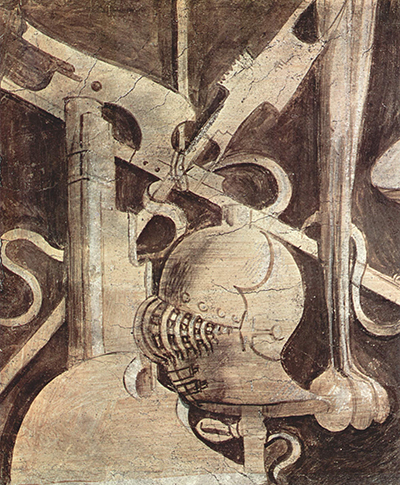Giorgione was either an impressively prolific artist or he was an extremely unfruitful one: he did not sign any of his work, and after five hundred years, his catalogue is a matter of educated estimation and painstaking deduction.
However, this piece, a detail from the much larger Frieze of the Liberal and Mechanical Arts, has wonderful provenance: it can be found in the house in which Giorgione himself was born! The whole frieze measures a lengthy 1588 centimetres long, by 77 centimetres high, snug against the ceiling and running the full length of the whole room. Thought to be a celebration of the progress of the times – the Italian Rennaisance was well under way when the frieze was completed, Copernicus was beginning to have interesting and heretical thoughts about the movements of the sun, and Leonardo da Vinci was finding out how the world was put together and working out ways to make it better – the frieze was later understood to be an expression of great unease.
While science and the arts were make huge strides, leading to the future age of enlightenment, there was still a great deal of superstition about. The unfortunate conjunction of the planets, combined with a much-dreaded total lunar eclipse, gave Giorgione and his contemporaries pause: their very thoughts were against the teachings of the church which had iron control over almost every aspect of life in those days. Armour, the detail in question, is a simple one, and yet it is satisfying in its very simplicity.
Giorgione was clearly emulating Leonardo da Vinci in his efforts to draw people and things as they are seen rather than as they are – all those odd-looking eyes in ancient Egyptian art are not mistakes, or stylistic choices, people have two eyes, therefore must be depicted as such, even if they are standing in such a way that only one eye can be seen! A clutter of weapons – a couple of crossed halberd-type weapons – and a set of bolas form the background, while a helmet rests on top of the halberds, next to a truncated arquebus that could pass for a modern day pistol.
The overall impression is that a weary soldier or sentry has returned home and dropped his weapons and helmet in a heap, all too ready to put his workday out of his head. For a warlike image, it is surprising tranquil. The frieze is depicted on a white wall, but Giorgione has created the images in reverse, light objects against a dark background which seems to have been made from diluted charcoal, perhaps applied with his fingers onto damp plaster, in haste before it dried. The frieze has been preserved, the house in which it is housed now a museum: the Casa Pellizzari, also known as Museo Giorgione.




